What happens when pets become “members of society”?
In August 2025, as temperatures soared to 39°C in Shanghai, a dog sporting a “Blue Dragon and White Tiger” tattoo on its back stunned attendees at the 27th Asia Pet Expo. Tattooed, dyed, and adorned with gold chains, such dogs are no longer isolated cases but emblematic of the pet economy’s shift toward extremes and entertainment.
As humans project their aesthetics, consumption, and emotions onto their “fur babies,” the pet industry is expanding at an unprecedented pace.
Meanwhile, Singapore has charted a radically different course. Here, cats and dogs not only face restrictions on “hair styling and dyeing” but must also be legally registered with licenses. From animal welfare and market order to social civility, Singapore employs a comprehensive framework to regulate the pet economy. This approach not only unlocks new business opportunities for the industry but also safeguards the well-being of our furry companions.

I. Insights from the 2025 Asia Pet Expo:
Exploring the Pet Economy and Industry Chain Expansion
1. The Spectacle of the Pet Expo: An Industry Celebration Where Humans and Pets Dance Together
On August 20, 2025, the 27th Asia Pet Expo (APE) opened at the Shanghai New International Expo Centre. This edition set new records:
Spanning 310,000 square meters, over 2,600 exhibitors and companies showcased more than 20,000 pet brands.
More than just a trade show, APE resembled a “pet carnival”: Fresh pet food, smart wearables, customized diets… virtually covering “a pet’s entire life.” Organizers even created immersive experience zones, allowing humans to envision what life would be like “if I were a pet.”
This event transcends an industry gathering—it’s a social phenomenon. As perceptions of pets shift from “guardians of the home” to “family members,” the pet economy has reached new heights.

Source: 2025 Asia Pet Expo
2. Consumption Trends: Three Key Divisions in the Pet Economy
According to the 2025 Taobao Tmall Pet Consumption Trends White Paper, pet spending is showing three major divisions:
Demographic Divisions: Young people under 24 and those over 50 are the fastest-growing “core pet owners.” The former seek novelty and personalization, while the latter prioritize companionship and emotional comfort.
Regional Segmentation: Pet ownership is growing fastest in third-tier and smaller cities, expanding beyond major metropolitan areas.
Purchasing Power Segmentation: Premium pet food and customized products are experiencing explosive growth. For example, Royal Canin’s “specialized diet” for Corgis precisely addresses issues like obesity and excessive shedding.
This signals that the pet economy has evolved beyond mere “canned food and kibble purchases,” transforming into a sophisticated, diversified, and scenario-based consumption trend.
3. Pet “Hair Styling and Dyeing”: When Consumption Crosses into Controversy
Yet behind the pet economy’s prosperity lie ethical debates. The “tattooed puppy” at the 2025 Asia Pet Expo exemplifies this.
Pet owners claimed “dogs feel no pain,” asserting the procedure was performed while the dog was fully conscious;
Spectators witnessed the puppy with drooping ears, tail tightly tucked, and eyes filled with terror;
After the incident surfaced, it ignited intense public debate over the line between “pet grooming” and “abuse.”
Similar practices include ear cropping, tail docking, and vocal cord removal. Some businesses market these as “grooming” or “noise prevention,” yet they inflict immense suffering on animals.
Consequently, while the pet economy presents new business opportunities, it has also been thrust into the ethical spotlight by public opinion. How to balance market demand with ethical boundaries has become an urgent question.
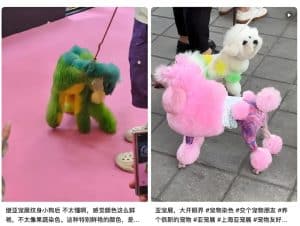
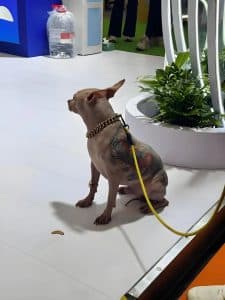

Image source: Vista Kan Tianxia, removed upon request

II. The Rise of Singapore’s Pet Economy:
How AVS Regulates the “Cat and Dog Economy”
1. What is AVS?
In Singapore, the pet economy has not developed into a “free-for-all.” Instead, it is strictly regulated by the Animal and Veterinary Services Division (AVS) under the National Parks Board (NParks).
AVS’s primary functions include:
① Approving licenses for pet sales, breeding, boarding, importation, and related businesses;
② Establishing pet welfare and management standards;
③ Ensuring animal health and public safety.
In other words, any business involving cats and dogs—from opening a store and sourcing inventory to sales and boarding—must operate within AVS’s licensing framework.

Source: Lianhe Zaobao
2. What Can Pet Stores Sell?
According to AVS regulations:
Permitted animals for sale: Cats, dogs, rabbits, fish (select species), birds (select species), rodents (e.g., hamsters, guinea pigs).
Prohibited animals: Protected wildlife, dangerous species (e.g., piranhas, certain frogs, specific turtles).
Businesses wishing to handle special animals must apply for additional permits under the Animals and Birds Act and obtain CITES permits or certificates of origin.
3. What licenses do pet shops require?
Opening a pet shop in Singapore requires multiple licenses beyond company registration:
Pet Sales License (applied for through AVS);
Pet Feed Import Permit (applied for through MTI);
Pet Breeding License (applied for through NParks/AVS);
Pet Boarding License (mandatory since 2022);
Company Registration (register business entity with ACRA);
Land Use Approval (approved by URA or HDB based on circumstances).
In other words, every pet-related business requires inter-agency joint approval, ensuring operators not only understand business management but also animal welfare and regulations.
4. Training Requirements: Operators Must Attend Courses
Interestingly, even opening a pet shop in Singapore requires prior education.
All operators must complete an AVS-accredited course in Pet Welfare and Animal Management (e.g., courses offered by Temasek Polytechnic) and obtain a valid certificate.
This isn’t merely a “formality”—it’s the state’s way of elevating practitioners’ animal welfare awareness through education, preventing ethical controversies like the “tattooed puppies” incident.
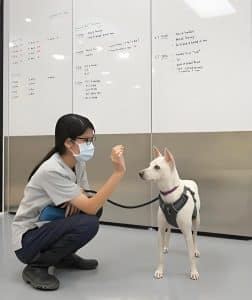
Source: Singapore AVS

III. Pet Ownership Rules:
How to Obtain Cat/Dog Pet Licenses?
Individual pet owners wishing to legally keep cats or dogs in Singapore must obtain a pet license. Entrepreneurs planning to open a pet shop must follow a comprehensive business licensing process.
1. How do individual pet owners register cats and dogs?
In Singapore, all cats and dogs must be registered under the regulatory framework:
Dogs: Must be microchipped and registered on the AVS platform to obtain a license.
Cats: Starting in 2024, all cats must be licensed, and owners must commit to spaying/neutering (unless approved exceptions apply).
Owners must apply through the GoBusiness platform, submitting:
① Pet details (breed, gender, age, etc.);
② Owner information;
③ Proof of sterilization and health certification.
④ Upon successful registration, pets receive “official identity” status, enabling government tracking for lost or abandoned animals.
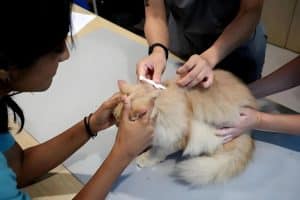
Source: Lianhe Zaobao
2. How to Open a Pet Shop? A Complete Guide
If you wish to open a pet shop, the general process is as follows:
① Register a company: Register your business with ACRA and open a local bank account;
② Training courses: Complete an AVS-approved pet management course and obtain certification;
③ License Application: Apply for licenses based on business scope, such as pet sales, breeding, or boarding;
④ Premises Approval: Obtain URA approval for premises use suitability; if involving HDB flats, secure a letter of no objection;
⑤ Additional Requirements: For activities like pet food sales, apply for import permits.
The entire process is submitted and tracked via the GoBusiness platform, streamlining procedures and ensuring regulatory transparency.
3. Why Mandatory Registration?
Singapore’s mandatory registration for cats and dogs isn’t “superfluous” but stems from three considerations:
Animal welfare: Ensuring pets are raised in legal, healthy environments;
Public safety: Preventing risks like bites and disease transmission;
Industry health: Curbing issues like “black market breeding” and “unscrupulous pet grooming.”
Within this framework, while the pet economy faces strict constraints, it becomes more orderly and sustainable.
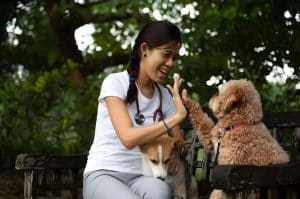
Source: Singapore AVS
Conclusion: Beyond Business Opportunities Lies Responsibility
The pet economy stands at a turning point: On one hand, the success of the Asia Pet Show signals immense commercial potential; on the other, controversies like “tattooed puppies” remind us that pets are not toys, but living beings deserving of respect and kindness.
Singapore’s approach offers a valuable model: integrating the pet economy into a legal framework through systems, licensing, and education. While this model imposes additional costs on businesses and extra procedures on pet owners, it fosters a healthier industry, a more civilized society, and ensures our furry friends lead dignified, secure lives.
Perms, dye jobs, and tattoos may grab fleeting attention, but sustainable new opportunities in the pet economy ultimately rest on science, responsibility, and love.
Note: Information sourced from Singapore AVS, GoBusiness, ACRA, NParks, Asia Pet Expo 2025, Lianhe Zaobao, Vista Global, Beijing News, and Beike Finance. Compiled from comprehensive news reports. Reproduction requires attribution; contact for removal if infringing…….
